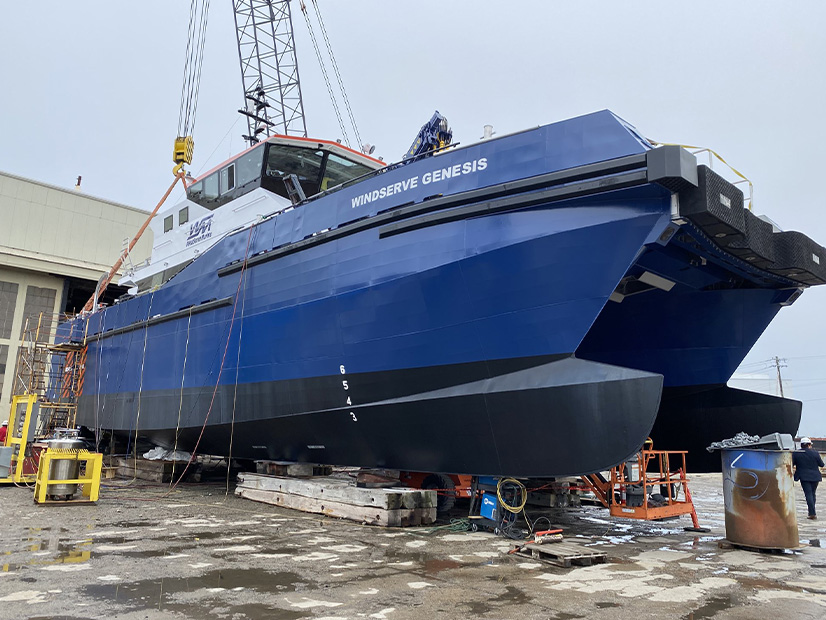
The offshore wind sector will need a $100 billion supply chain investment to meet the 2030 targets policymakers have set, a new analysis finds.
The offshore wind sector will need a $100 billion supply chain investment to meet the 2030 targets that policymakers have set, a new analysis finds.
Wood Mackenzie’s report issued this month, “Cross Currents: Charting a Sustainable Course for Offshore Wind,” explores the disconnect between the desire to build offshore wind and the ability to manufacture the components. It compares a baseline increase in generation capacity of up to 30 GW per year with policymakers’ goals of up to 77 GW per year. To accomplish this, much more money must be plowed into the supply chain: $27 billion by 2026, and more than $100 billion by 2030, the report finds.
This bumps up against investor hesitation because of low margins and uncertainty of project timing in the offshore wind sector, the authors say.
Suggested solutions include extending the planning process beyond 2030, building better supplier-develop partnerships and capping turbine size to pause manufacturers’ race to build ever-larger machinery.
The report finds this “arms race” is particularly damaging, shortening the timeframe to recover investments and recoup research-and-development costs, increasing the cost of installation and repairs and rendering expensive equipment and facilities obsolete if they can handle a 12-MW turbine but not its 15-MW successor or the 18-MW prototype under development.
It also notes that 24 GW of projects scheduled to come online in 2025-2027 have secured a subsidy or power purchase agreement but have not made a final investment decision. Multiple projects are delayed worldwide as they seek to renegotiate offtake contracts to reflect their rising costs.
Delays, Constraints
Chris Seiple, vice chair of power and renewables at Wood Mackenzie and co-author of the report, said governments’ commitment to offshore wind is clear but the supply chain will be an impediment to achieving their targets.
“Nearly 80 GW of annual installations to meet all government targets is not realistic,” Seiple said in a news release. “Even achieving our forecasted 30 GW in additions will prove unrealistic if there isn’t immediate investment in the supply chain.”
Another factor, Seiple said, was an oversupply that followed a supply chain buildout a decade ago, depressing profitability.
“Burned once, current suppliers are cautious in their investment plans, and the lack of profitability is hampering their ability to fund manufacturing capacity expansion — ultimately stalling innovation in the sector.”
Given the decade-plus time needed to realize a return on investment, there is hesitation by manufacturers to supercharge a buildout that peaks in 2030 and then subsides. To counter this, the authors suggest not setting the 2030 goal too high and creating a clear post-2030 road map.
The report excludes one major player in the offshore sector — China — because it relies largely on a domestic supply chain and because that supply chain largely has not extended abroad. But that could change as Chinese companies look to expand their markets, the authors note.
2026 Estimates
The report’s estimated need for $27 billion in investments by 2026 is closely focused — not on a full supply chain buildout, just what is required for installation, foundations, towers, blades and nacelles. None of this can come from the onshore wind supply chain, they noted, because of the size differential.
Installation of equipment offshore is the largest gap, the report finds, because half of the fleet of ships is too small to handle the next generation of supersize turbines. More than 20 new vessels are needed, at an estimated cost of $13 billion.
Foundations — massive steel tubes driven into the seabed — are needed in greater number and larger size. But scaling up manufacturing capacity is more challenging than with other components because of their sheer bulk, and because of the customization needed for individual sites.
The towers that stand on the foundations are getting larger and more complicated as the turbines that sit on top of them grow more powerful, rendering some factories obsolete. Many plans have been announced to expand them or build new ones, but only a third have reached a final investment decision.
Nacelles are the bright spot in the report, deemed the least likely to become a supply chain bottleneck because of the firm commitment manufacturers have made to expanding production capacity. The sticking point might be coordinating expansion of the suppliers of all the components of a typical nacelle.
Blade manufacturing requires ongoing investment because of demand growth and retooling to produce longer blades. Manufacturers are sustaining losses or limited profit as a result and have committed to only a fraction of the $4 billion investment needed in new factories, which typically have a three- to five-year lead time.
The authors also note that the supply chain has become highly concentrated in the past decade — to the point that the top three manufacturers of foundations, towers, blades and nacelles account for 67%, 70%, 93% and 96% of their markets, respectively. This allows them greater influence on pricing and timing in their industries.


